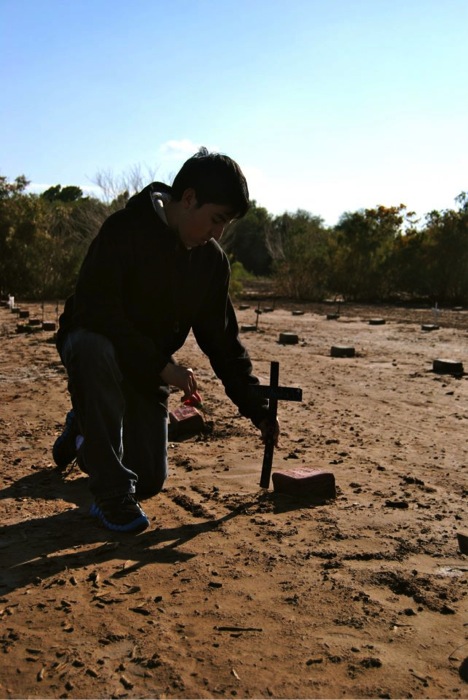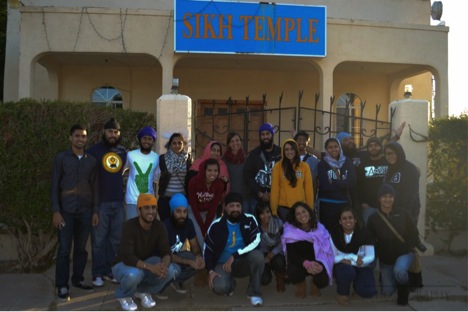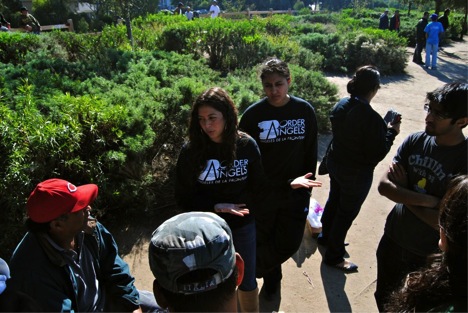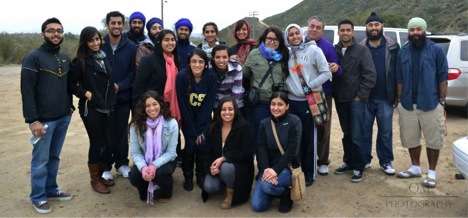
J.Korps 2011 – SUJH and Border Angels
 First off, my sincere apologies to all in delaying the posting of this entry for far too long. Over winter break, nearly 20 students participated in the Jakara j.Korps initiative that seeks to explore the issue of immigration. Here is a photo-essay composed by Josh Singh.
First off, my sincere apologies to all in delaying the posting of this entry for far too long. Over winter break, nearly 20 students participated in the Jakara j.Korps initiative that seeks to explore the issue of immigration. Here is a photo-essay composed by Josh Singh.
During winter break 2011 members of the Jakara Movement were brought together for the first annual SUJH Alternative Winter Break to examine the issue of immigration first-hand by visiting the so-called ground zero, the Mexi-Cali border. The issue of illegal immigration continues to be brought to the forefront as witnessed in the divisiveness this issue caused among 2012 Republican primary candidates and the recent rise of nativist sentiment that has been fueled by deteriorating economic conditions. In 2006, huge protests calling for a more open and humane immigration policy were lead mostly by our Chicano/a and Latino/a brothers and sisters. The Sikh-American response to this issue however has been largely indifferent and silent. Through this trip, our goal was to break down commonly held conceptions about undocumented migrants and their journey into the U.S. (sujh=becoming aware). One of the most common misperceptions among people is that illegal immigration is a Latino-centric issue and therefore primarily deserves attention from that community. However, as seen in the LA times article earlier this year highlighting the increasing number of undocumented Punjabi workers in the U.S. (1600 were caught and detained in 2010 alone), this is hardly the case. It is imperative for us to stand in solidarity with other communities, especially on issues we have a personal stake in. Otherwise, how can we expect them to support issues that are deeply important to us?
Day 1- Orientation/Friendship Park
The day began with an orientation from Border Angels, our partner organization. Here is a brief description from their website:
Founded by Enrique Morones in 1986, Border Angels is a non-profit organization supporting humanity. The organization consists of extraordinary volunteers who want to stop unnecessary deaths of individuals traveling through the Imperial Valley desert areas and the mountain areas surrounding San Diego County, as well as the areas located around the United States and Mexican border. The high percentage of unnecessary deaths have been results of extreme heat and cold weather conditions, in addition some have sadly been the results of racial-discrimination crimes. Steps Needed To Be Taken Spring and Summer Months: With horrifically hot temperature conditions, hundreds of rescue stations are located along the ten state US Mexico border region. Temperatures reaching as high as 127 degrees, water is critical for survival. Volunteers maintain stations throughout the spring and summer months. Fall and Winter Months: Critical life-saving stations are established throughout the San Diego Mountain areas. Winter clothing, food and water are placed in winter storage bins to help decrease negative health results from being exposed to the incredibly freezing temperature changes that exists in the San Diego County mountain areas during the Fall and Winter. Awareness and Support Educating citizens and government dignitaries on the status of weather related deaths and racial-discrimination crime deaths is crucial in gaining support in the volunteer, donation and jurisdiction areas. Border Angels are proud supporters of Equal Rights.
On the first day, we explored Friendship Park, a historically significant site in the immigrant rights’ movement. Situated right along the Pacific Ocean, it marks the beginning of the U.S.-Mexico border fence. In the past, separated families on both sides of the border would meet at this location. Bush-era policies have resulted in significant construction additions to the fence, making face-to-face communication impossible in recent years. Border Angels and several organizations are working on making this a more open, friendlier environment as it was intended. To read more about the history of Friendship Park, you can go on their website here.


Enrique Morones, Angels’ founder, told us several personal stories of his experiences organizing the Marcha Migrante. This annual march occurs in remembrance of the individuals who have died crossing the border and to show support for immigration reform. As mentioned above, the march in 2006 received a great deal of media coverage and consisted of protests throughout the country. One of the most inspiring parts of the trip was to see how Enrique has completely devoted his life and career to the cause of immigrant rights as human rights.

Another issue our group sought to explore was undocumented migrants’ access to healthcare. Later that evening, we read and discussed a dissertation related to healthcare access among Punjabi migrants in Germany (read an interview with the author here). Aside from describing the immense risks these immigrants were willing to take in order to reach Europe, this article highlighted the challenges that they faced in trying to obtain basic health services. It also revealed the huge importance of the gurdwara as a place where one could meet contacts in order to obtain access to medicines and basic healthcare services, as well as jobs.
Day 2- Desert/El Centro Gurdwara
We began our second day with heading out towards the Imperial Valley. Our first stop was along the U.S.-Mexico border wall. Surrounding us were Border Enforcement patrols (who were unwilling to talk to us) while their helicopters were continuously circling us above. We were able to talk extensively with a young boy living on the Mexican side of the fence.


A few miles off the highway, Enrique showed us areas in the canyons that migrants often cross, miles upon miles of desert and rocky terrain. He told us personal stories of the people he has met, helped, and learned from. It was incredible to see the lengths that potential migrants are willing to overcome, crossing severely inhospitable areas all in the pursuit of a better life. We left several humanitarian items including water and blankets along the paths for any potential wayfarers. In the spirit of Bhai Khaniya, no one shall die of thirst. Dehydration and environmental conditions are the top causes of death for people attempting to cross. We also learned about so-called minute men who often slash the water bottles left by border angels and other groups.


We then stopped at a local cemetery in Holtville, CA. In the front of the cemetery are the usual tombstones, grass, and flowers, but in the back of the cemetery is what is referred to as the “potter’s field”. It is here where hundreds of people, most often unidentified, are given their final resting place. The local county sends the bodies there. Over 700 people have been buried there since 2010 alone. It is the largest unmarked mass burial site in the United States. Most are only marked by a brick that reads ‘John/Jane Doe.’ In the future, many of our own Sikh brothers and sisters may wind up there. For many of these unidentified migrants, no word is ever sent to their families and loved ones miles away. It was very reminiscent of Jaswant Singh Khalra’s work, reminding us that this uncertainty is the worse part. Border Angels puts crosses on these spots that read “No Olividados” (Not forgotten), so while we may not know the names and backgrounds of these men and women, collectively they have not been forgotten.


On our way back to San Diego, we visited the Gurdwara in El Centro. This historical gurdwara documents the early 20th century settlement of Sikhs in California and is the second oldest Gurdwara in the United States, after the first in Stockton, CA. The PBS documentary Roots in the Sand explores the early Punjabi-Mexican community of the Imperial Valley. At the Gurdwara, we met up with David Dhillon, a descendant of this pioneering community and a former mayor of the town. He described the significant efforts made by these early Punjabi immigrants to make the barren land productive enough for farming. Since most of their children and grandchildren were raised Catholic in accordance with their mother’s religion, including David, there are virtually no descendants of this community who identify themselves as Sikh. Although the gurdwara once had a thriving sangat, there are only a few families who come here today. Given the limited economic opportunities in this region, the future of this historic gurdwara and the local sangat remains to be seen.

Day 3-Day Laborers
Our final day was spent visiting the local Home Depot. We met with Luis and a number of day laborers. We brought them lunches and water, and provided them information about local health clinics. With smiles and a shake of hands, they expressed their gratitude. They expressed no political rants, but simply told us their amazing stories of the sacrifices they made in all in the pursuit of a better life. Border Angels is currently working with the city of San Diego to make the day laborers’ space a public loading zone.

Many of our preconceived notions and myths were broken down. Some of these myths include:
Immigrants don’t want to learn English
- The development of English proficiency among non-English speaking immigrants today mirrors that of Nineteenth and early Twentieth century immigration, when masses of Italian, German, and Eastern European immigrants came to America. While first generation, non-English speaking immigrants predictably have lower rates of English proficiency than native speakers, 91% of second generation immigrants are fluent or near fluent English speakers. By the third generation, 97% speak English fluently or near fluently. (Source: Shirin Hakimzadeh and D’Vera Cohn, “English Usage Among Hispanics in the United States,” Pew Hispanic Forum, Dec. 6, 2007.
Immigrants Don’t Pay Taxes
- Undocumented immigrants pay taxes. Between one half and three quarters of undocumented immigrants pay state and federal taxes. They also contribute to Medicare and provide as much as 7 billion dollars a year to the Social Security Fund. Further still, undocumented workers pay sales taxes where applicable and property taxes—directly if they own and indirectly if they rent. (Source: Immigration Policy Center, “Undocumented Immigrants as Taxpayers,” (November 2007)
- Recent research has shown that immigrant communities do not increase the crime rate and that immigrants commit fewer crimes than native born Americans. While the undocumented immigrant population doubled from 1994 to 2005, violent crime dropped by 34% and property crimes decreased by 32%. Furthermore, Harvard sociologist Robert Sampson has found that first generation immigrants are 45% less likely to commit violent crimes than Americanized, third generation immigrants. (Source: Immigration Policy Center, “Ímmigrants and Crime: Are They Connected,” December, 2007)
Immigrants Take Jobs Away from Americans
- A recent study produced by the Pew Hispanic Center reveals that “Rapid increases in the foreign-born population at the state level are not associated with negative effects on the employment of native-born workers.” In fact, given that the number of native born low wage earners is falling nationally, immigrants are playing an important role in offsetting that decline. The Urban Institute reports that between 2000 and 2005 the total number of low wage workers declined by approximately 1.8 million while the number of unskilled immigrant workers increased by 620,000, thus offsetting the total decline by about a third. (Source: The Urban Institute, “Trends in the Low-Wage Immigrant Labor Force, 2000-2005,” March, 2007).














